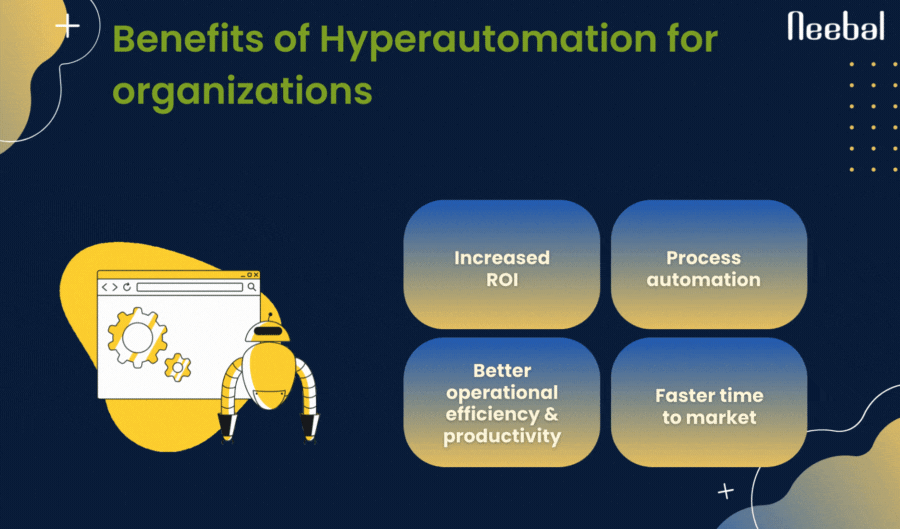The way businesses operate has undergone a paradigm shift; with automation assuming more importance than ever. The pandemic augmented this need further; according to research by the IBM Institute for Business Value, 59% of the surveyed enterprises stated that the pandemic has advanced the need for digital transformation.
Hyperautomation is an agile approach to maximize the benefit of digital transformation for enterprises. It is the application of cognitive technologies such as Robotic Process Automation (RPA), Machine Learning (ML), Artificial Intelligence (AI), Process Mining, and intelligent Business Process Management Software (iBPMS), among others, to augment and automate processes in a more dynamic way than traditional automation.
Hyperautomation is not just combining and leveraging several technologies, but also strategically redesigning the entire process. It requires a robust roadmap to automate end-to-end business operations across enterprises.
The need to switch to Hyperautomation
Hyperautomation empowers workers to reimagine their tasks without depending upon or operating with the limitations of any single technology. With a clear process redesign, workers are satisfied, empowered, and contribute more to cognitive and customer-facing tasks. Combined with software bots or digital workers, enterprises free their personnel from mundane, repetitive tasks that occupy a major chunk of their day. The monotonous processes get an overhaul with advanced technologies like RPA, AI, and ML.
Here are some key indicators that signal organizations to move from traditional automation:
Depending on legacy systems
When multiple systems are entangled in the business operations with legacy business data, no single tool can help. It requires multiple intelligent and complementary technologies to bring the systems together.
Heavy human-dependent tasks
Processes replete with tedious, repetitive tasks, take more time and potentially impact employee productivity. Besides, low-cognitive and routine tasks bring down the morale of workers, let aside the inevitable errors that hamper the quality of work. RPA bots help enterprises overcome and rectify these flaws.
For instance, when a software bot is deployed in a labor-intensive process in the BFSI sector for the document generation process, it works round the clock, increasing the output and speeding up the process by multiple times, without errors.

Greater risks of compliance
Regardless of the type of business, adherence and compliance to regulations for any industry and geography are critical. Hyperautomation tools automate regulations, compliance, and risk factors as part of the process orchestration.
Lack of transparency
Managing business processes traditionally, i.e, manually, makes tracing important data difficult. Achieving visibility into business operations demands a lot of time and effort. If workers are manually handling compliance with siloed functions, spreadsheets, and shared files, poor data quality, and disconnected systems, it’s high time to make the digital shift.
Benefits of Hyperautomation for organizations
Increased ROI
Hyper-automating the right processes lowers lead times, reduces process times, and eliminates inefficiencies. By combining RPA with AI and machine learning, Hyperautomation maximizes the benefits and improves ROI.
Process automation
An automated ecosystem saves workers’ time allowing them to focus on more complex, value-adding tasks. For instance; order management, in which RPA bots retrieve attachments/emails and update in internal systems; perform document processing such as data extraction; assess risk models for loan underwriting; collect data and validate customer profiles to detect fraudulent cases. The opportunities are endless.
Better operational efficiency & productivity
Hyperautomation reduces companies’ workload by automating and expediting routine processes such as data extraction, data entry, invoicing, supplier management, claims processing, etc. freeing workers from such monotonous tasks. End-to-end automation enables better strategic business decisions and enhances productivity.
Faster time to market
In the progressively competitive world, it’s important to scale up and reduce the time to market by accelerating production. But how can enterprises achieve this? The answer is by leveraging low-code, which enables application development 10 to 20 times faster than conventional development. Low-code is a proactive approach to software development that requires minimal coding experience to design applications, empowering workers.
Conclusion:
Hyperautomation accelerates enterprises’ digital transformation journey by optimizing the business processes, enabling them to stay ahead in this increasingly competitive and advanced world.
How can Neebal help?
With Hyperautomation, Neebal automated several processes and provided detailed insights into sales forecasts of one of the leading agrochemical companies, resulting in an 80% reduction in time taken for achieving similar results.
Are you ready to implement Hyperautomation for your business? Schedule a call with our experts to get your digital transformation journey started!
